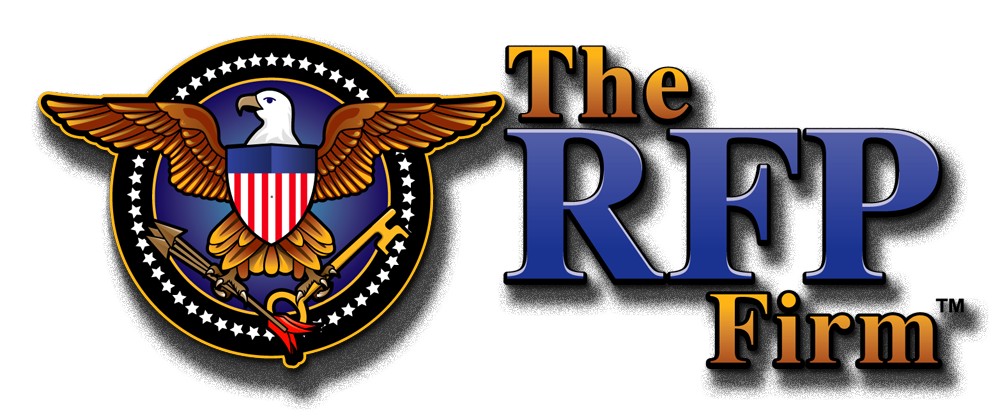Blog
Government & Commercial Proposal Writing Services
 The RFP Firm is expert at writing proposals in Response to Federal and State Government RFP Solicitations that will give you a Competitive Advantage over your competition.
The RFP Firm is expert at writing proposals in Response to Federal and State Government RFP Solicitations that will give you a Competitive Advantage over your competition.


Proposal Writing Services , RFP Proposal Consulting, Government RFP writing
Government RFP Proposal Writing Services
A Guide for Demystifying Government Request for Proposals for Small Business
In the world of business, opportunities abound, but few are as intriguing, and often daunting, as the prospect of securing government contracts. Small businesses, in particular, can find themselves overwhelmed when confronted with a Government Request for Proposal (RFP). These documents, laden with acronyms and bureaucratic jargon, often seem like insurmountable hurdles. However, The RFP Firm can provide the right guidance and approach to enable Small Businesses to navigate this complex terrain successfully. This guide aims to demystify Government Request for Proposals, breaking down the process into manageable steps that can help small businesses seize their share of the lucrative government contracts.
Understanding the Basics: What is a Government Request for Proposal (RFP)?
Before we dive into the intricacies of responding to an RFP, let’s establish a solid foundation. A Government Request for Proposal is a formal document issued by a government agency, outlining the requirements and expectations for a specific project. This document invites businesses to submit proposals outlining how they will fulfill those requirements. Government RFPs are an essential part of the procurement process, ensuring transparency, competition, and adherence to government regulations.
Research and Preparation: Lay the Groundwork
The first step in successfully navigating a Government Request for Proposal is thorough research and preparation. Small businesses should not rush into responding to RFPs blindly. Here’s how to get started:
Begin by identifying government agencies and departments that regularly procure the goods or services your business provides. Look for industry-specific websites, subscribe to notifications from government procurement portals, and attend industry events and webinars to stay updated on potential RFPs. Reviewing past RFPs from the agencies you are interested in can provide valuable insights. Understand the language and requirements commonly used in their RFPs. This will help you tailor your responses to their expectations.
Crafting the Perfect Proposal: Key Components
Responding to a Government Request for Proposal is a meticulous process that involves several essential components. Ensuring that your proposal addresses these key elements can significantly improve your chances of success. Your proposal should include a concise executive summary that highlights the main points of your proposal. This section should provide a clear, compelling overview of your business and its capabilities, setting the stage for the rest of your response.
The heart of your proposal lies in the technical approach section. Here, you’ll describe how your business plans to fulfill the requirements of the RFP. Be specific, addressing all aspects of the project and showcasing your expertise. Highlight your past experience and track record. Discuss similar projects you’ve successfully completed, emphasizing their relevance to the current RFP. This provides evidence of your capability to deliver. Introduce the key members of your team who will be working on the project. Emphasize their qualifications, experience, and how their skills align with the project’s requirements.
Clearly outline your pricing and cost structure. Ensure that your pricing is competitive while maintaining profitability. Be transparent about your pricing model to build trust with the government agency.
Compliance and Documentation: Meeting Legal and Administrative Requirements
One of the most critical aspects of responding to a Government Request for Proposal is ensuring that you comply with all legal and administrative requirements. Failure to do so can lead to disqualification. Here’s how to manage this effectively:
Thoroughly review the RFP document, paying attention to all requirements, deadlines, and submission instructions. Make a checklist to ensure you address each element. Ensure that your business is properly registered, and all necessary certifications are up to date. This may include SAM registration for U.S. federal contracts or other industry-specific certifications. Meticulously proofread and edit your proposal. Typos, formatting errors, or missing documents can create a negative impression.
Building Relationships: Networking and Partnering
Small businesses often underestimate the value of networking and partnering in the government procurement world. Building relationships can open doors and lead to more opportunities to respond to Government Request for Proposals. Participate in industry conferences, expos, and networking events where government representatives and potential partners are present. This is an excellent way to build connections. Consider partnering with larger businesses as a subcontractor on government contracts. This can provide experience and credibility, making it easier to win prime contracts in the future. Many government agencies have small business offices dedicated to helping small businesses navigate the procurement process. Engaging with these offices can provide valuable guidance and support.
Submission and Follow-Up: The Final Push
Once you’ve completed your proposal, it’s time to submit and follow up. This stage requires attention to detail and timely action. Adhere to the submission deadline specified in the RFP. Late submissions are often disqualified. Follow up with the government agency to confirm they have received your proposal. This ensures it wasn’t lost in the process. Be prepared to address any questions or requests for clarification from the government agency promptly. This demonstrates your commitment and professionalism.
Learn from Rejections: Continuous Improvement
Government Request for Proposals are highly competitive, and rejections are not uncommon. It’s essential to view each rejection as an opportunity for improvement. If your proposal is rejected, don’t hesitate to request feedback from the government agency. Their insights can help you refine your approach. Review your proposal and approach, identify areas for improvement, and adapt for future submissions. Learning from past experiences is crucial for long-term success.
In conclusion, navigating Government Request for Proposals can be challenging for small businesses, but with the right approach, it’s entirely achievable. Understanding the basics, thorough preparation, crafting a compelling proposal, ensuring compliance, building relationships, and persistent follow-up are key to success in the world of government contracting. Keep in mind that each rejection is a steppingstone toward improvement.
The RFP Firm can help to demystifying the RFP process and communicate your strategy so that your small business can seize the lucrative opportunities offered by government contracts.